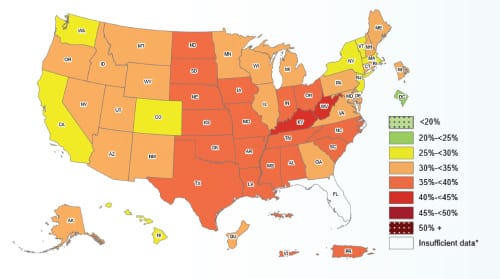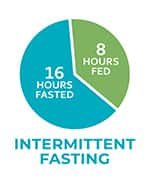Life Extension Magazine®
Obesity prevalence has tripled across the globe since 1975.1
Nearly 60% of Europe’s adults are now overweight or obese.2
A record 73% of Americans are in this category—with nearly 10% defined as severely obese.3-5
The penalty for this glut of body fat is premature illness and death.6
Healthcare systems worldwide struggle to handle surging numbers of patients afflicted with obesity-related diseases.7,8
An impediment to shedding pounds with low calorie diets is that our body turns down energy expenditure to conserve calories as body fat.
This biological response is called adaptive thermogenesis9,10 and is explained in the next column.
- Thermogenesis converts calories into heat energy. Extra calories not burned get stored as body fat. 11,12
- Adaptive in this instance means turning down thermogenic rate in response to reduced food intake.
Adaptive thermogenesis is a factor that thwarts most reduced-calorie diets because decreased calorie burn results in less fat loss. 9,10
Judicious use of agents to boost metabolic rates while reducing calorie intake is a promising strategy to help people lose weight.12
A low-cost method has been found to do just that, i.e., increase energy expenditure without creating stimulatory side effects.12
This month’s issue describes how one can safely augment a weight loss program.
Prevalence of Self-Reported Obesity Among U.S. Adults by State and Territory, BRFSS, 2021
Content source: Centers for Disease Control and Prevention.3
This map shows Prevalence of self reported obesity among U.S. Adults by state and territory, BRFSS, 2021.
Reference to specific commercial products, manufacturers, companies, or trademarks does not constitute its endorsement or recommendation by the U.S. Government, Department of Health and Human Services, or Centers for Disease Control and Prevention.
This material is otherwise available on the agency website for no charge.
* Sample size <50, the relative standard error (dividing the standard error by the prevalence) >30%, or no data in a specfic year.
Rational Use of Metabolism-Enhancing Agents
Thermogenesis occurs when the body converts a meal including fats into heat energy.12
When one goes on a low-calorie diet, thermogenesis decreases over time and creates a “resistance to weight loss.” 10,12
This occurs as the body compensates for low calorie intake by burning less calories, (reduced thermogenesis) thus causing excess weight to stay on.10,12 It is a source of frustration to those working to shed fat pounds and keep them off.
A method of counteracting a slowdown in thermogenesis is to take a safe dose of a metabolism-enhancing agent to boost energy expenditure.
Red chili peppers have been shown to reduce the risk of becoming overweight or obese. 13,14 People who include red chili peppers in their diet have a lower overall mortality risk.15-17
Capsaicin is a compound found in red chili peppers that increasesthermogenesis, thus supporting weight loss.14,18-23
Tolerability and Bioavailability
Supplements containing capsaicin have been sold for decades, but some people experience digestive upset when using them. 24
The major challenge of benefiting from capsaicin is its low bioavailability. It has a short half-life because of rapid metabolism that occurs in the liver.
A novel formulation helps overcome some of these challenges by delivering a functional dose of capsaicin without the digestive irritations.24,25
This improved bioavailability, low cost, plus safe thermogenic mechanism make capsaicin a rational adjunct for those seeking meaningful weight loss results.
Clinical Trial Reveals Modest Effects in 28 days
The use of thermogenesis-enhancing agents, typically combined with calorie reduction, has a potential to induce modest weight loss.22
In order to test the efficacy of a new capsaicin formula, a 28-day placebo-controlled study was conducted.
Overweight volunteers took a 200 mg daily dose of standardized capsaicin that was enclosed in a plant fiber to provide greater systemic bioavailability of the capsaicin.
No changes in food intake or physical activity levels were advised over this brief study period.
The capsaicin group lost 2.1% of their body weight compared to 0.32% for the placebo arm of the study in four weeks.25
For Those Interested in Intermittent Fasting
A growing number of people engage in time-restricted eating where they fast for about 16-hours most days and only eat during an 8-hour window.
Others consume very low or no calories two days each week.
Time-restricted eating produces many health benefits, but after some time their bodies adapt to a low-calorie diet and no longer sustain much weight loss. One reason may be that the body senses food scarcity during the fasting period and conserves energy (body fat).9,10
Use of an effective capsaicin formula to increase energy expenditure combined with time-restricted eating or reduced calorie intake may be better for removing stubborn fat stores.14,18-23
This 2.1% of weight loss occurred over a brief (28-day) period without the volunteers engaging in the kinds of low-calorie diets that overweight/obese individuals need to shed meaningful body fat.
This study supports previous research showing that capsaicin boosts fat-burning energy expenditure without the stimulatory effects encountered with caffeine-ephedrine formulas.12
To achieve sustained reductions in body fat, however, decreased calorie consumption along with some increase in physical activity is highly recommended.
A More Comprehensive Approach
The primary benefit of a thermogenic agent is for people committed to achieving a long-term reduction in body weight.
This usually requires a multi-modal approach that requires a combination of reduced calorie intake and increased energy expenditure through physical activity.9,21
Taking the recommended dose of a thermogenesis-enhancing compound is a rational and promising complement to this approach.
By safely increasing thermogenesis, one will likely lose more fat pounds especially when combined with a healthier lifestyle that includes reducing excess calories.
Boosting metabolic rate using a thermogenic compound enables a more comprehensive approach to losing excess body fat than dieting alone.
Based on the 28-day study described earlier, a 225-pound person using this new bioavailable capsaicin would lose about 5 pounds the first month.
A more comprehensive approach is to combine capsaicin with:
- Reduced calorie intake
- Increased physical activity
- Compounds that boost AMPK activity, like the drug metformin or the plant extract gynostemma pentaphyllum.
This multi-modal strategy will likely produce more sustained results over an extended time period.
Tragedy of Delayed Weight Loss
When obesity-induced illnesses like type II diabetes strike, a multitude of co-morbidities can follow that include painful neuropathies, kidney impairment, visual disturbances, coronary atherosclerosis, dementia, fatty liver, and/or ischemic stroke.6,8,14,21,26,27
Those who have been overweight for decades often complain about the many degenerative conditions that relentlessly strike them.
I explain to these individuals that tissue damage has been smoldering in their overweight body for decades, and outward symptoms of these pathologies are only now emerging.
The optimal time to shed excess body fat is before serious illnesses develop that are often irreversible.
When combined with a healthier lifestyle, using a thermogenic compound to maintain metabolic rates represents a multi-pronged approach to cutting more body fat.
The article on page 42 describes the weight loss mechanisms that occur in response to boosting thermogenic energy expenditure.
I hope our readers who harbor excess fat pounds can lose at least 10% of their body weight in 2023.
Significant health and longevity benefits occur in those who achieve even modest body fat loss.28
For longer life,
William Faloon
References
- Available at: https://www.who.int/news-room/fact-sheets/detail/obesity-and-overweight#:~:text=Worldwide%20obesity%20has%20nearly%20tripled,%2C%20and%2013%25%20were%20obese. Accessed October, 29, 2022.
- Available at: https://apps.who.int/iris/handle/10665/353747. Accessed October, 29, 2022.
- Available at: https://www.cdc.gov/obesity/data/prevalence-maps.html. Accessed October, 28, 2022.
- Available at: https://www.medpagetoday.com/primarycare/obesity/90142. Accessed October, 28, 2023.
- Ward ZJ, Bleich SN, Cradock AL, et al. Projected U.S. State-Level Prevalence of Adult Obesity and Severe Obesity. N Engl J Med. 2019 Dec 19;381(25):2440-50.
- Field AE, Coakley EH, Must A, et al. Impact of overweight on the risk of developing common chronic diseases during a 10-year period. Arch Intern Med. 2001 Jul 9;161(13):1581-6.
- Tremmel M, Gerdtham UG, Nilsson PM, et al. Economic Burden of Obesity: A Systematic Literature Review. Int J Environ Res Public Health. 2017 Apr 19;14(4).
- Pi-Sunyer X. The medical risks of obesity. Postgrad Med. 2009 Nov;121(6):21-33.
- Leibel RL, Rosenbaum M, Hirsch J. Changes in energy expenditure resulting from altered body weight. N Engl J Med. 1995 Mar 9;332(10):621-8.
- Ebbeling CB, Swain JF, Feldman HA, et al. Effects of dietary composition on energy expenditure during weight-loss maintenance. JAMA. 2012 Jun 27;307(24):2627-34.
- Ho KKY. Diet-induced thermogenesis: fake friend or foe? Journal of Endocrinology. 2018 01 Sep. 2018;238(3):R185-R91.
- Stohs SJ, Badmaev V. A Review of Natural Stimulant and Non-stimulant Thermogenic Agents. Phytother Res. 2016 May;30(5):732-40.
- Shi Z, Riley M, Taylor AW, et al. Chilli consumption and the incidence of overweight and obesity in a Chinese adult population. Int J Obes (Lond). 2017 Jul;41(7):1074-9.
- Varghese S, Kubatka P, Rodrigo L, et al. Chili pepper as a body weight-loss food. Int J Food Sci Nutr. 2017 Jun;68(4):392-401.
- Bonaccio M, Di Castelnuovo A, Costanzo S, et al. Chili Pepper Consumption and Mortality in Italian Adults. J Am Coll Cardiol. 2019 Dec 24;74(25):3139-49.
- Chopan M, Littenberg B. The Association of Hot Red Chili Pepper Consumption and Mortality: A Large Population-Based Cohort Study. PLoS One. 2017;12(1):e0169876.
- Qu H, Lv M, Xu H. Piperine: bioactivities and structural modifications. Mini Rev Med Chem. 2015;15(2):145-56.
- Takeda Y, Dai P. Capsaicin directly promotes adipocyte browning in the chemical compound-induced brown adipocytes converted from human dermal fibroblasts. Sci Rep. 2022 Apr 22;12(1):6612.
- Urbina SL, Roberts MD, Kephart WC, et al. Effects of twelve weeks of capsaicinoid supplementation on body composition, appetite and self-reported caloric intake in overweight individuals. Appetite. 2017 Jun 1;113:264-73.
- Whiting S, Derbyshire E, Tiwari BK. Capsaicinoids and capsinoids. A potential role for weight management? A systematic review of the evidence. Appetite. 2012 Oct;59(2):341-8.
- Zheng J, Zheng S, Feng Q, et al. Dietary capsaicin and its anti-obesity potency: from mechanism to clinical implications. Biosci Rep. 2017 Jun 30;37(3).
- Becher T, Palanisamy S, Kramer DJ, et al. Brown adipose tissue is associated with cardiometabolic health. Nat Med. 2021 Jan;27(1):58-65.
- Fernandez-Verdejo R, Marlatt KL, Ravussin E, et al. Contribution of brown adipose tissue to human energy metabolism. Mol Aspects Med. 2019 Aug;68:82-9.
- Joseph A, Nm J, Kumar S, et al. Safety assessment of a fenugreek dietary fiber-based formulation of capsaicinoids-rich red chili (Capsicum annum) extract (Capsifen®): Acute and sub-chronic studies. Toxicol Rep. 2020;7:602-9.
- Joseph MA, John Ph DF, Thomas MJV, et al. Influence of a Novel Food-Grade Formulation of Red Chili Extract (Capsicum annum) on Overweight Subjects: Randomized, Double-Blinded, Placebo-Controlled Study. J Diet Suppl. 2021;18(4):387-405.
- Sun F, Xiong S, Zhu Z. Dietary Capsaicin Protects Cardiometabolic Organs from Dysfunction. Nutrients. 2016 Apr 25;8(5).
- Rosengren A, Wedel H, Wilhelmsen L. Body weight and weight gain during adult life in men in relation to coronary heart disease and mortality. A prospective population study. Eur Heart J. 1999 Feb;20(4):269-77.
- Ryan DH, Yockey SR. Weight Loss and Improvement in Comorbidity: Differences at 5%, 10%, 15%, and Over. Curr Obes Rep. 2017 Jun;6(2):187-94.







